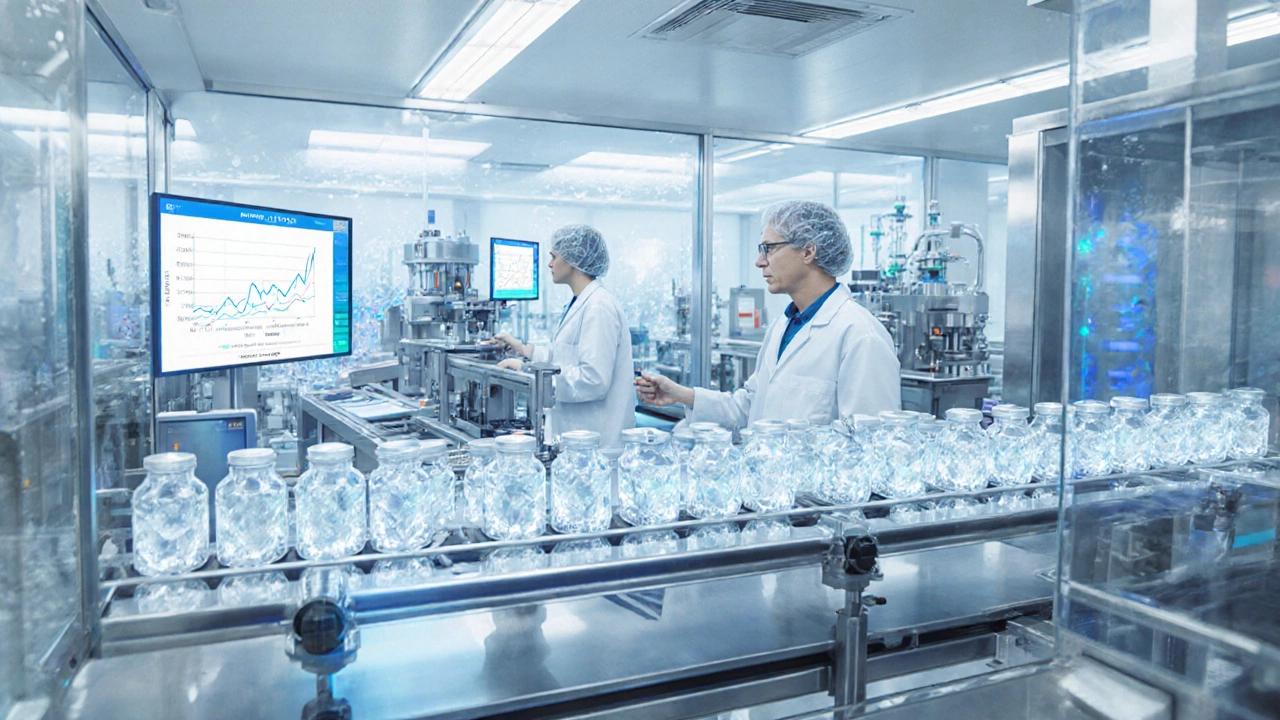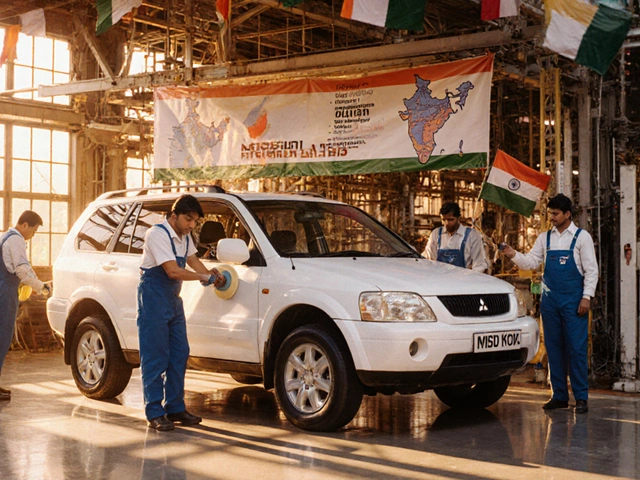Manufacturing Sector Profitability Calculator
This tool helps you evaluate the profitability potential of different manufacturing sectors based on key financial metrics. Select a sector to compare its performance against others.
Pharmaceutical
22% Net MarginElectronics
18% Net MarginFood Processing
10-12% Net MarginAutomobile
12-18% Net MarginSteel
13% Net MarginFurniture
8-12% Net MarginSector Comparison Details
Select a sector above to view detailed profitability metrics
Profitability Checklist
Before choosing a sector, consider these factors:
- Capital size required for entry
- Regulatory compliance requirements
- Skill availability in your region
- Market demand trends
- Supply chain reliability
- Scalability potential
Key Takeaways
- Pharmaceutical and electronics manufacturing consistently post 15‑25% net margins.
- Food processing offers fast cash flow with 10‑12% margins and low entry capital.
- Automobile and steel sectors need heavy investment but can achieve 12‑18% returns in a growing market.
- Choose a sector that matches your capital, expertise, and regional demand.
- Use the profitability checklist to avoid common traps like over‑capacity and regulatory delays.
How to Measure Profitability in Manufacturing
Profitability isn’t just about revenue; it’s the ratio of profit to the money you actually put into the business. The most reliable metrics are:
- Net profit margin - net profit divided by total sales. It shows how much of each rupee stays after all costs.
- Return on capital employed (ROCE) - profit relative to the total capital invested, useful for capital‑intensive sectors.
- Compound annual growth rate (CAGR) - tells you how fast the market is expanding, which can boost future margins.
- Cash conversion cycle - how quickly you turn raw material into cash. Short cycles improve liquidity.
When comparing industries, line up these numbers side by side. A sector with a 20% net margin but a 30‑year payback may be less attractive than one with a 12% margin and a three‑year payback.

Top High‑Margin Manufacturing Sectors in 2025
Below are the eight most profitable manufacturing categories based on recent Indian and global reports, plus real‑world examples that illustrate how they perform on the metrics above.
Pharmaceutical manufacturing is a regulated, high‑value sector that produces medicines, vaccines, and nutraceuticals. In 2024, the Indian pharma industry reported an average net profit margin of 22% and a CAGR of 13% driven by exports and a growing domestic health market. Companies like Sun Pharma and Cipla capitalise on patented generics to maintain strong cash flows.
Electronics manufacturing covers printed circuit boards, consumer gadgets, and automotive electronics. The sector’s net margins hover around 18%, with a CAGR of 11% as 5G rollout and electric vehicle (EV) demand surge. Major players such as Foxconn’s India plant and local OEMs leverage scale to keep unit costs low.
Food processing transforms raw agricultural produce into packaged foods, dairy, and beverages. Margins average 10‑12%, but the cash conversion cycle is short-often under 45 days-making it attractive for entrepreneurs with limited working capital. Brands like Britannia and Amul illustrate how brand equity adds premium pricing.
Automobile manufacturing includes passenger cars, two‑wheelers, and commercial vehicles. Though capital‑intensive, the sector can deliver 12‑18% ROCE when aligned with government incentives for EVs and export incentives. Tata Motors and Mahindra leverage strong supplier ecosystems to improve margins.
Steel manufacturing remains a backbone industry for infrastructure. Modern mini‑mill operations achieve net margins of 13% and benefit from a 9% CAGR as government projects push demand. Companies such as JSW Steel have adopted high‑efficiency furnaces to cut energy costs.
Furniture manufacturing caters to both domestic and export markets, especially in modular and eco‑friendly designs. Margins sit at 8‑10%, but value‑added finishes and customisation can push them above 12% for niche players.
Textile manufacturing still dominates in labour‑intensive regions. Net margins are modest, around 6‑8%, but a 7% CAGR and strong export demand for technical fabrics keep the sector viable for scale‑focused entrepreneurs.
Chemical manufacturing produces specialty chemicals, polymers, and agro‑chemicals. High barriers to entry lead to net margins of 15% for niche specialties, with a CAGR of 8% driven by industrial demand.
Comparison of Profitability Factors
| Sector | Avg. Net Margin | CAGR (2021‑2025) | Typical Capital Investment (US$M) | ROCE | Cash Cycle (Days) |
|---|---|---|---|---|---|
| Pharmaceutical manufacturing | 22% | 13% | 10‑30 | 25‑30% | 60‑90 |
| Electronics manufacturing | 18% | 11% | 15‑40 | 20‑25% | 45‑70 |
| Food processing | 10‑12% | 9% | 2‑8 | 15‑20% | 30‑45 |
| Automobile manufacturing | 12‑18% | 10% | 50‑200 | 18‑22% | 80‑120 |
| Steel manufacturing | 13% | 9% | 30‑120 | 20‑24% | 70‑100 |
| Furniture manufacturing | 8‑12% | 7% | 5‑15 | 12‑16% | 50‑80 |
| Textile manufacturing | 6‑8% | 7% | 4‑12 | 10‑14% | 60‑90 |
| Chemical manufacturing | 15% | 8% | 12‑25 | 22‑26% | 70‑100 |
Profitability Checklist - Picking the Right Manufacturing Business
- Capital size: Do you have the funds for heavy‑equipment sectors like steel or automobiles?
- Regulatory landscape: Pharmaceutical and chemical plants need licences; ensure you can meet compliance.
- Skill availability: High‑tech sectors need trained engineers; labour‑intensive sectors rely on skilled workers.
- Market demand: Look for growing domestic consumption (e.g., EVs) or export pipelines (e.g., pharma).
- Supply chain resilience: Secure raw material sources to avoid cost spikes.
- Scalability: Can you expand capacity without proportionally increasing overhead?

Common Pitfalls and How to Avoid Them
Even the most profitable sectors can turn sour if you miss the basics.
- Under‑estimating working capital: Fast‑turning sectors like food processing still need buffer stock for seasonal spikes.
- Neglecting compliance: A missed pharma licence can shut you down for months.
- Over‑capacity: Building a 200‑ton steel mill without confirmed orders leads to idle assets.
- Ignoring technology upgrades: Electronics manufacturers that stick with outdated equipment lose margin to rivals.
- Misreading market trends: Betting on a fading textile fad can erode profits fast.
Next Steps - From Idea to Revenue
- Validate demand: Conduct surveys, talk to distributors, and check government procurement data.
- Prepare a financial model: Include capex, OPEX, tax incentives, and break‑even analysis.
- Secure approvals: Apply for environmental clearances, industry licences, and tax registrations.
- Choose a location: Proximity to raw material hubs (e.g., pharma clusters in Gujarat) reduces logistics cost.
- Build a pilot line: Start small, test quality, and iterate before full‑scale rollout.
- Scale with partners: Tie up with contract manufacturers or OEMs to share risk.
Following these steps helps you translate the data on the most profitable manufacturing business into a real, cash‑generating operation.
Frequently Asked Questions
Which manufacturing sector requires the lowest start‑up capital?
Food processing and small‑scale textile units often start with less than $5million, especially if you lease equipment and use existing market channels.
Is pharmaceutical manufacturing still profitable despite strict regulations?
Yes. The sector’s high entry barriers protect margins, and the surge in generic drug demand keeps net margins above 20% on average.
How does the EV boom affect automobile manufacturing profitability?
EV components-batteries, power electronics-carry higher unit margins. Government subsidies on EV plants also boost ROCE, making the sub‑segment more attractive than conventional cars.
What are the biggest tax incentives for new manufacturers in India?
Schemes like the Production‑Linked Incentive (PLI) for electronics, pharma, and medical devices, plus accelerated depreciation on plant assets, can reduce effective tax rates by 5‑7%.
Should I outsource production or set up my own plant?
Outsourcing lowers capital risk and speeds market entry, ideal for first‑time manufacturers. Own plants give tighter quality control and higher long‑term margins once demand stabilises.





